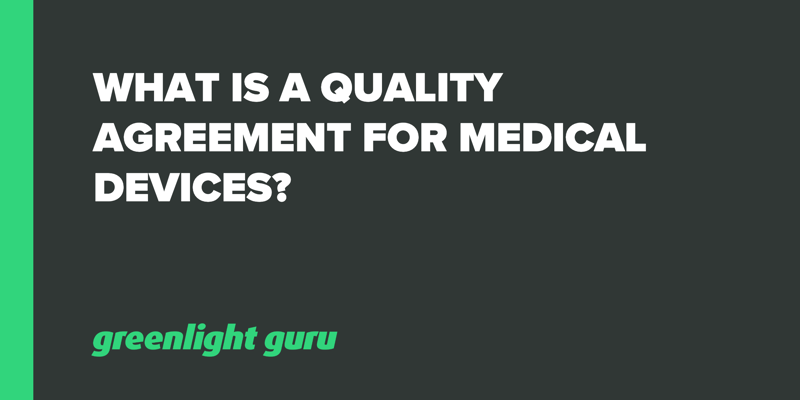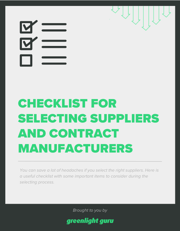
There’s a good chance you’re not manufacturing your own medical device—contract medical device manufacturing is growing at a compound annual growth rate of roughly 11%. Even if you are manufacturing the device yourself, you’re likely using a materials supplier.
Your medical device’s success rests on a successful partnership with your contract manufacturers. But how can you make that happen?
A quality agreement ensures that you and your materials supplier or contract manufacturer are on the same page by laying out a foundation of quality and communication standards. It plays a vital role in helping you avoid fines—which, for some medical device companies, can be tens of millions of dollars—and deliver the best product possible.
What is a quality agreement for medical devices?
A quality agreement for medical devices is a written agreement ensuring that suppliers manufacture your product and send you materials according to predetermined specs.
It solidifies what kinds of communication and changes are appropriate between your party and the manufacturer and what changes your manufacturer or supplier is allowed to make, as well as the regulatory requirements that must be followed for compliance.
Certain regulatory bodies around the globe may require a quality agreement. But others, like the U.S. Food and Drug Administration (FDA) don’t require medical device manufacturers to have a quality agreement.
However, FDA does, in its Quality System Regulation, lay out numerous requirements that a quality agreement must cover. So even though the FDA doesn’t explicitly require a quality agreement, creating one may still help you meet other requirements.
Remember: even if the FDA doesn't require a quality agreement, it shows them that you take quality seriously. Insisting on a quality agreement from the get-go also signals to your prospective partners that you prioritize quality, and that your company is likely efficient and more likely to generate profit.
Quality Agreements also keep you in the loop with your supplier, reducing the chances of anything going under your radar. Quality agreements require cooperation between both parties, so it’s only natural that you and your partner will grow to communicate better over time while ensuring the agreement is honored.
What is the difference between a quality agreement and supplier agreement?
Both quality agreements and supplier agreements are essential to getting and keeping a medical device on the market. With that said, each lay out different requirements in the manufacturer and supplier relationship.
Quality agreement
A quality agreement focuses solely on the Current Good Manufacturing Practices (CGMP) of FDA, which outlines the following:
-
What kinds of changes the supplier can make without contacting you: In the case of a materials supplier, these kinds of changes might entail swapping out materials or dimensions of material delivered. For a contract manufacturer, changes might entail adhesives or storage conditions.
-
Regulatory requirements that your device needs to meet: If your device needs to get approval from a particular governing body in the event of being in numerous markets, your agreement should outline this process. Device approval depends on your partner abiding by the governing body’s guidelines, so this section is especially important.
-
Who to contact regarding quality and corrective and preventive action (CAPA) matters: You need to contact your supplier in the event of a quality event, such as a nonconformance or CAPA. The quality agreement will state who to contact, how to contact them, and what additional steps to take.
Supplier agreement
A supplier agreement focuses more on liability matters and logistics, including the following:
-
Mold and tooling ownership: Any designs are likely yours, so make sure the agreement states that. Stating mold and tool ownership ensures that the contractor returns what’s yours when the job’s over. This section should also clarify who covers the cost if any part breaks during manufacturing.
-
Business terms and conditions: Use this section to lay out the period of work and any termination clause, and identify who should be contacted regarding anything outside of the CAPA and quality issues outlined in the quality agreement.
-
Bill of materials and cost negotiations: It’s best to figure out material costs, shipping and delivery windows, and so on before you get started. Spell out everything in your supplier agreement to ensure there are no nasty surprises when production gets going.
-
Confidentiality: Your supplier may be privy to information about your product or process that isn’t intended for the public, or at least not intended for public knowledge at the moment. Use this section of your agreement to ensure both parties know what can and can’t be shared with the public—or competitors.
-
Liability matters: Consult with your legal counsel to account for any potential liability issues ahead of time, and spell out those protections in your supplier agreement.
Keep in mind the two agreements serve very different purposes; having one agreement doesn’t mean you don’t need the other.
How does a quality agreement function within supplier management?
A quality agreement isn’t just a legally binding set of rules. It is also an integral part of supplier management and facilitates the building of a working relationship. The process of creating a quality agreement makes this relationship-building apparent:
-
All relevant stakeholders meet and begin drafting up the agreement together. It’s not a requirement that lawyers be present, but their insight is valuable. Keep in mind, the inclusion of lawyers may result in a longer process.
-
Work closely with your contract manufacturer or supplier to ensure that the agreement is satisfactory. Multiple drafts over back-and-forth communication are likely.
-
Once both parties are satisfied with the agreement, have your legal team perform a full review. Your legal team will review the agreement and ensure that any necessary legal verbiage is present and that the agreement meets agency requirements.
Once your quality agreement is complete, both parties may begin the actual process of working together and putting the agreement into action.
What should a quality agreement contain?
Quality agreements may vary from company to company, but every agreement should cover several essential areas based on logistics and FDA requirements:
-
The ultimate goal of your quality agreement: Lay out the scope of the project, both parties’ expectations, and the end goal of the agreement. This section is essentially the terms of the entire relationship.
-
Communication standards: Outline who will be contacted for which problems. For example, you might have two separate contacts for questions about order size versus questions about material substitutes. You may also want to discuss how, in the event of an audit, requests for documentation may be handled. Your auditors may request copies of records which need to be provided by the supplier, so be sure to discuss what the hand-off will entail.
-
Quality management requirements: Outline whether you require the supplier to use a quality management system (QMS). You’ll want to include details about how to manage applicable processes within the QMS as well as assign ownership of tasks to be performed by members of your organization. For example, you’ll need someone to take point on updating any supplier relation movement within the QMS. Also, it’s a good idea to invite them to your quality management platform if you’re already utilizing one.
-
Design controls: If you’re creating a Class II or Class III medical device, you’ll need to adhere to the FDA design control requirements and document all related procedures and activities in your quality agreement. This will ensure that your product is developed and designed with certain safety measures in place.
-
Additional FDA controls: Beyond design controls, you’ll also need to outline what labeling, production, process, and packaging controls your device has to follow. Just like the design controls, you’ll want to make it clear in your agreement what steps your contract manufacturer must take in order to comply with regulations.
-
Location of work: The agreement should dictate where the supplier will handle the work, and it should call out multiple locations if there’s more than one work site. Many companies also require a notification should the supplier relocate their operation.
-
Procedural protocols: The quality agreement should contain any and all protocols, such as how to handle materials or what documentation requires updating.
-
Length of the agreement: Simply put, the quality agreement needs to have clear start and end dates and should lay out any conditions that would result in a contract termination.
-
Quality management protocols: Specify how the supplier should handle material storage, a CAPA-related event or nonconformance, or any other factors pertaining to quality.
When you feel your quality agreement is complete, review the applicable sections from 21 CFR Part 820 with your quality and legal teams to make sure your agreement follows FDA requirements.
Streamline your quality agreement coordination, execution & management
A quality agreement acts as the foundation for any productive partnership between your company and a supplier or manufacturer. You’ll also want the best quality management software to help you execute the various activities of your quality agreement and streamline communication between your entire team and your supplier or contract manufacturer.
Greenlight Guru offers the only quality management software designed exclusively for the medical device industry. The purpose-built platform can be implemented in a matter of days and offers dedicated workflows that allow internal and external teams to work faster and collaborate better.
See how Greenlight Guru can help you meet your goals, stay organized, and build a strong supplier relationship.
Looking for an all-in-one QMS solution to advance the success of your in-market devices and integrates your post-market activities with product development efforts? Click here to take a quick tour of Greenlight Guru's Medical Device QMS software →
Taylor Brown is a Medical Device Guru, certified Lead Auditor for ISO 13485, and a card-carrying Quality Nerd. She got her start in the industry as a technical writer and quickly became an audit readiness and support specialist, traveling around the United States to establish ISO 13485 compliant quality systems. She...









